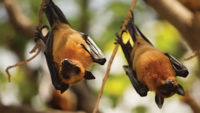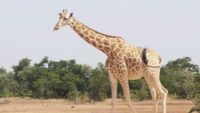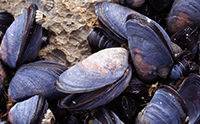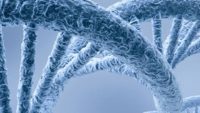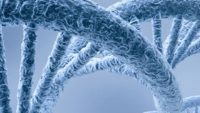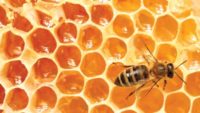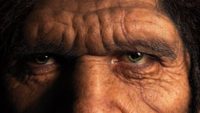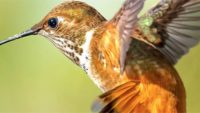By Dr. Elizabeth Mitchell We’ve all heard that, compared to mammalian animals like dogs, humans have a poor sense of smell. Did you know that this notion is a 19th century myth? …read more Source: AIG Daily
By Karin Viet The gecko is designed to climb. Scientists had to magnify the gecko’s foot thousands of times to find out its secret to defying gravity. …read more Source: AIG Daily
The giant conch shell has been hailed by evolutionists as ‘one of nature’s greatest engineering masterpieces’. What makes it so special? …read more Source: creation.com
By Frank Sherwin We read in Genesis 1:31 that God made everything “very good.” If everything that God made was good, where did Giardia come from? …read more Source: AIG Daily
By Karin Viet As the only true flying mammals, bats are well equipped for the hunt. Their wings can maneuver nimbly to abruptly change directions and carry them swiftly. …read more Source: AIG Daily
By Dr. David Menton Evolutionists insist that the underlying similarity of all animals, including man, is compelling evidence for their evolution from a common ancestor. …read more Source: AIG Daily
How human-like were Neanderthals? Apparently human enough to try some dentistry, but it didn’t work too well. University of Kansas anthropologist David Frayer led a study of a Neanderthal’s teeth. He told KU News, “It was an interesting connection or collection of phenomena that fit together in a way that we would expect a modern human to do.” More… …read more Source: icr.org
By Avery Foley A new study has shown that it’s not just newborns that prefer faces. Unborn babies in the third trimester of pregnancy show this same affinity for faces. …read more Source: AIG Daily
This commonly asked question has wider implications when the origin of life is considered. …read more Source: creation.com
By Karin Viet The giraffe strolls on stilt-like legs, and its neck parades high in the sky. But the giraffe is no comic freak of nature. It displays divine design. …read more Source: AIG Daily
By Ken Ham The more we study God’s creation, the more we realize how complex and beautifully designed it is. I was reminded of this truth when I learned about how the drab brown or pearly scales of the juvenile ocellated lizard change to a green and black adult lizard “using a computer-like process,” about God’s marvelous design in nature, especially in reptiles. Thanks for stopping by and thanks for praying,Ken This item was written with the assistance of AiG’s research team. …read more Source: Ken Ham AIG
Asphalt volcanos really do exist on the ocean floor. They ooze natural gas, oil, and the same type of black glop we use for road pavement. Unique sea creatures team up to eat these petroleum products. Asphalt volcanos and their inhabitants inspire a few good creation questions, such as how could any living thing live off natural gas? More… …read more Source: icr.org
By Dr. Nathaniel T. Jeanson Venema claims that the published, comprehensive genetic comparisons between humans and chimpanzees reveal a genetic identity of 95–98%. …read more Source: AIG Daily
Bugs in the deep help you to breathe deeply. …read more Source: creation.com
Finding Adam in the Genome: Part 2 of a Response to Chapter 2 (and Chapter 4) of Adam and the Genome
By Dr. Nathaniel T. Jeanson In our series, we’ve discovered ample support that evolutionists fit facts to conclusions. In this article, we’ll continue to explore whether it is true. …read more Read more here: AIG Daily
By Karin Viet What is the largest animal of all time—even larger than the most massive dinosaurs? The answer is the blue whale. …read more Read more here: AIG Daily
Animals used to be vegetarian, and they will be again. Should we feed animals a vegetarian diet now? …read more Read more here: creation.com
It’s true that cats have an uncanny ability to land on their feet. But that doesn’t make them invulnerable. …read more Source: creation.com
Finding Adam in the Genome: Part 1 of a Response to Chapter 2 (and Chapter 4) of Adam and the Genome
By Dr. Nathaniel T. Jeanson In this post, we begin exploring Venema’s evidences in chapter two of Adam and the Genome, titled “Genomes as Language, Genomes as Books.” …read more Source: AIG Daily
In June, 2017, thousands of scientists from around the world attended the 65th Annual Conference of the American Society for Mass Spectrometry in Indianapolis. One of the thousands of research projects on display at this year’s conference compared portable man-made sniffers to dog noses. Whose design won? More… …read more Source: icr.org
By Dr. David Menton Evolutionists speculate that life gradually evolved from mere hydrogen in a series of stages. …read more Read more here: AIG Daily
The biblical narrative that the first Egyptian Dynasty descended from the biblical Ham, the son of Noah, as told in the book of Genesis, could well be supported by recent research based on DNA taken from Egyptian mummies, analysts said. According to CNN, researchers from the University of Tuebingen and the Max Planck Institute for the Science of Human History in Jena, both in Germany, found “unexpected results” when decoding the genome of ancient Egyptians. Their work, published online in Nature Communications, concluded that preserved remains found in Abusir-el Meleq, Middle Egypt, were the closest genetic relatives of Neolithic and [More]
Finding Adam in the Genome: Part 1 of a Response to Chapter 2 (and Chapter 4) of Adam and the Genome
By Dr. Nathaniel T. Jeanson In this post, we begin exploring Venema’s evidences in chapter two of Adam and the Genome, titled “Genomes as Language, Genomes as Books.” …read more Read more here: AIG Daily
By Karin Viet A single worker bee may add merely one-twelfth of a teaspoon of prized honey to its colony. Yet the power of the bee is in the cooperation of the colony. …read more Read more here: AIG Daily
By Jean O’Micks This study provides further evidence that Homo naledi is indeed not a member of the human holobaramin, but related rather to australopiths. …read more Read more here: AIG Daily
Wherever you live in the world, there’s generally a cat not too far away. …read more Read more here: creation.com
By Tom Hennigan We marvel at birds in flight. But one kind of bird stands apart in its acrobatic talents, with a complex flight system unlike any other. …read more Read more here: AIG Daily























